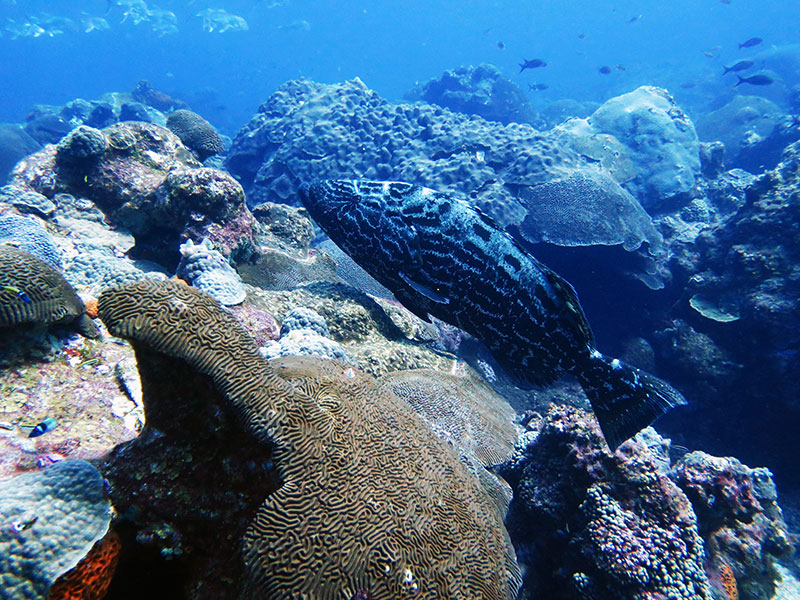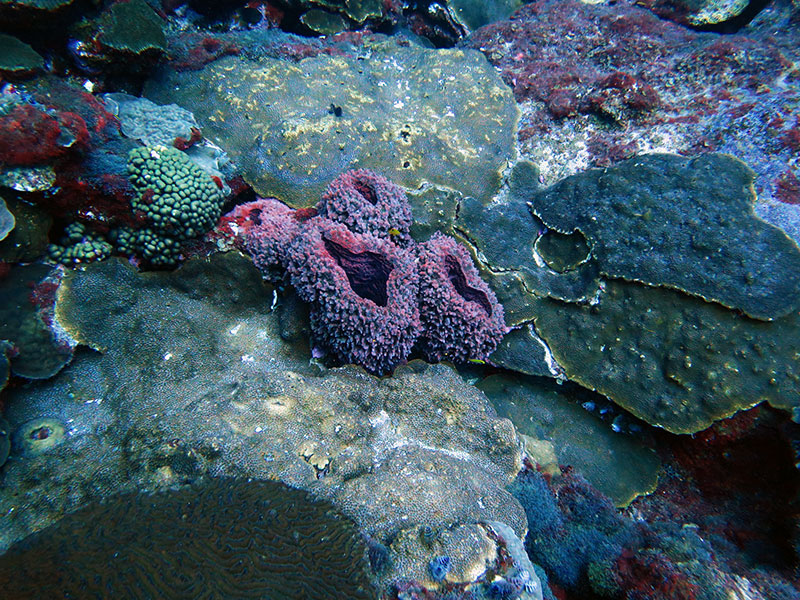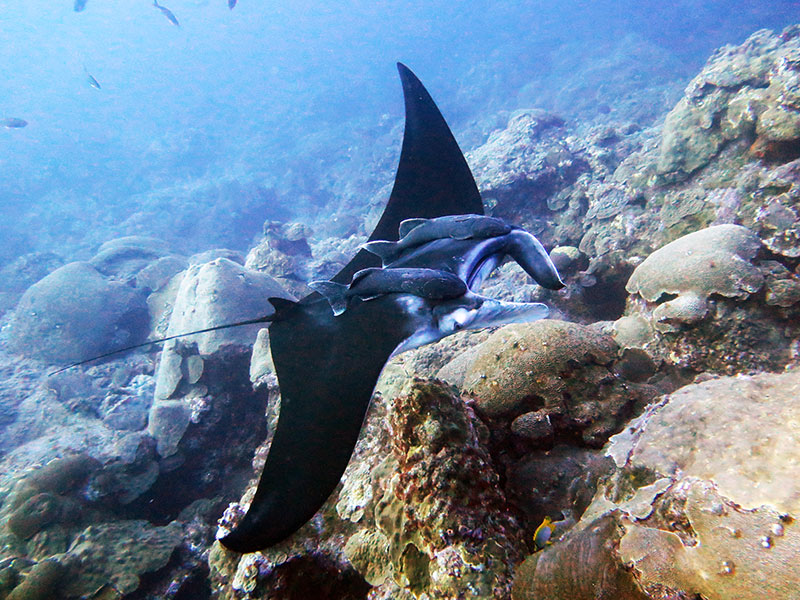
By Joshua Voss, Ph.D., Executive Director for NOAA’s Cooperative Institute for Ocean Exploration, Research, and Technology; Assistant Research Professor, Harbor Branch Oceanographic Institute at Florida Atlantic University
May 9, 2019

The highly complex coral formations of the Flower Garden Banks provide habitat for large grouper species, including this 70-centimeter (2.3-foot) black grouper, Mycteroperca bonaci, commonly seen at West Flower Garden Bank. A large school of jacks can also be seen in the background, which typically move between banks along the continental shelf margin in the Gulf of Mexico. Image courtesy of the Voss Lab at Florida Atlantic University, Harbor Branch. Download larger version (jpg, 9.1 MB).
The Flower Garden Banks National Marine Sanctuary (FGBNMS) in the northwestern Gulf of Mexico is comprised of stunning and unique continental shelf-edge coral reef habitats. The sanctuary contains the northernmost coral reefs in the continental United States. The closest shallow coral reefs are located in the Bay of Campeche, Mexico, approximately 650 kilometers (403 miles) to the south.
While many coral reefs globally and in the wider Caribbean have experienced declines in the past 30–40 years, coral reefs in the FGBNMS remain healthy, flourishing, and the least impacted in the tropical western Atlantic. Despite their location in sub-tropical latitudes, reefs in the FGBNMS experience relatively stable and warm-water temperatures, which support coral cover in excess of 50 percent from 18 to approximately 50 meters (59 to approximately 164 feet) deep.

Due to its high-latitude location within the Gulf of Mexico, the Flower Garden Banks hosts only 31 of the 82 scleractinian coral species found elsewhere in the Caribbean. However, coral cover remains close to 50 percent and is dominated by Orbicella spp., Montastraea cavernosa, Colpophyllia natans, and Pseudodiploria strigosa. Image courtesy of the Voss Lab at Florida Atlantic University, Harbor Branch. Download larger version (jpg, 10.8 MB).

Highly migratory species, including manta rays (pictured), sharks, and turtles are common visitors to the food-rich coral caps of the Flower Garden Banks. Image courtesy of the Voss Lab at Florida Atlantic University, Harbor Branch. Download larger version (jpg, 9.5 MB).
Of the approximately 82 species of hard corals found throughout the tropical western Atlantic, 31 species have been recorded in the FGBNMS. The sanctuary’s reefs at East and West Flower Garden Banks are dominated by large colonies of Orbicella spp., Pseudodiploria spp., Montastraea cavernosa, and Colpophyllia natans.
On the shallow coral caps (0–30 meters, 0–98 feet), coral colonies typically exhibit mounding/boulder morphologies. From approximately 30–50 meters (approximately 98–164 feet) in the upper mesophotic zone, coral colonies begin to exhibit flat, plating morphologies with less dense coral skeletons. Both lower light levels in the upper mesophotic zone and changing water flow patterns drive these changes in coral skeletal morphology with depth. Below 50 meters (164 feet), the relative abundance and percent cover of hard corals decreases dramatically.

Coral colonies can grow to enormous proportions, often over one meter (three feet) in diameter or height. These colonies contribute to the high complexity of the coral caps and provide habitat for a diverse array of fishes and invertebrates. Image courtesy of the Voss Lab at Florida Atlantic University, Harbor Branch. Download larger version (jpg, 9.1 MB).
Previous research by my lab using microsatellite genetic markers from the coral species Montastraea cavernosa demonstrated strong connectivity among FGBNMS and nearby mesophotic reefs/banks. By combining these population genetic data with a biophysical model estimating larval migration within the northwestern Gulf of Mexico, we hypothesize that some of the reefs/banks under consideration for sanctuary expansion likely contribute to the FGBNMS population.
Next year, we will collect and analyze samples that will expand these earlier connectivity analyses across the northwestern Gulf of Mexico with additional species and higher resolution using single nucleotide polymorphism (SNP) population genetics markers. By more fully characterizing both horizontal and vertical patterns of connectivity among coral reef organisms, we hope to better understand the drivers of population persistence in this region and support the development of effective management strategies.

While bleaching events are considered uncommon in Flower Garden Banks National Marine Sanctuary, a thermal anomaly in 2016 caused widespread bleaching of corals on the coral caps at both West and East Flower Garden Banks. Image courtesy of the Voss Lab at Florida Atlantic University, Harbor Branch. Download larger version (jpg, 10.7 MB).